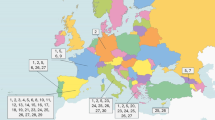Abstract
Tritrichomonas foetus has been identified as the causative agent of feline intestinal trichomonosis, characterized by clinical signs of chronic large bowel diarrhoea. This disease has been reported in cats from the USA, Europe and Australia. However, its epidemiology is still unclear. The aim of the present study was to describe T. foetus infection in a Persian cattery in Spain. T. foetus infection was sequentially diagnosed in 20 cats by direct faecal smear examined under the microscope, specific culture (In Pouch TF medium) and PCR. A standard coprological sedimentation method was also performed in order to screen for other intestinal parasites in all the cats included. In addition, sera were tested for IgG antibodies against Leishmania infantum, Toxoplasma gondii, and for the detection of feline immunodeficiency virus (FIV) and feline leukaemia virus (FeLV). Five out of 20 cats were positive for T. foetus (25%), two of them by microscopy, culture and PCR and three by culture and PCR. No association was found between T. foetus infection and age or sex. L. infantum and T. gondii seroprevalence rates were 15% and 10%, respectively. The prevalence of FeLV p27 antigen and of FIV antibodies in the study population was zero. Cystoisospora spp. oocysts were detected in one cat. These preliminary results show that the transmission of T. foetus infection in cluster conditions may occur between asymptomatic cats and young or immunocompromised animals.

Similar content being viewed by others
References
Ayllon T, Tesouro MA, Amusategui I, Villaescusa A, Rodriguez-Franco F, Sainz A (2008) Serologic and molecular evaluation of Leishmania infantum in cats from Central Spain. Ann N Y Acad Sci 1149:361–364
Bell ET, Gowan RA, Lingard AE, McCoy RJ, Šlapeta J, Malik R (2010) Naturally occurring Tritrichomonas foetus infections in Australian cats: 38 cases. J Feline Med Surg 12:889–898
Desmonts G, Remington JS (1980) Direct agglutination test for diagnosis of Toxoplasma infection: method for increasing sensitivity and specificity. J Clin Microbiol 11:562–568
Felleisen RSJ (1999) Host–parasite interaction in bovine infection with Tritrichomonas foetus. Microbes Infect 1:807–816
Felleisen RS, Lambelet N, Bachmann P, Nicolet J, Müller N, Gottstein B (1998) Detection of Tritrichomonas foetus by PCR and DNA enzyme immunoassay based on rRNA gene unit sequences. J Clin Microbiol 36:513–519
Foster DM, Gookin JL, Poore MF, Stebbins ME, Levy MG (2004) Outcome of cats with diarrhoea and Trichomonas foetus infection. J Am Vet Med Assoc 225:888–892
Frey CF, Schild M, Hemphill A, Stünzi P, Müller N, Gottstein B, Burgener IA (2009) Intestinal Tritrichomonas foetus infection in cats in Switzerland detected by in vitro cultivation and PCR. Parasitol Res 104(4):783–788
Gookin JL, Breitschwerdt EB, Levy MG, Gager RB (1999) Diarrhoea associated with trichomonosis in cats. J Am Vet Med Assoc 215:1450–1454
Gookin JL, Stebbins ME, Hunt H, Burlone K, Fulton M, Hochel R, Taalat M, Poore M, Levy MG (2004) Prevalence of and risk factors for feline Tritrichomonas foetus and Giardia infection. J Clin Microbiol 42:2707–2710
Gookin JL, Copple CN, Papich MG, Poore MF, Stauffer SH, Birkenheuer AJ, Twedt DC, Levy MG (2006) Efficacy of ronidazole for treatment of feline Tritrichomonas foetus infection. J Vet Intern Med 20:536–543
Gunn-Moore DA, McCann TM, Reed N, Simpson KE, Tennant B (2007) Prevalence of Tritrichomonas foetus infection in cats with diarrhoea in the UK. J Feline Med Surg 9:214–218
Hale S, Norris JM, Šlapeta J (2009) Prolonged resilience of Tritrichomonas foetus in cat faeces at ambient temperature. Vet Parasitol 166:60–65
Holliday M, Deni D, Gunn-Moore DA (2009) Tritrichomonas foetus infection in cats with diarrhoea in a rescue colony in Italy. J Feline Med Surg 11:131–134
Levy MG, Gookin JL, Poore M, Birkenheuer AJ, Dykstra MJ, Litaker RW (2003) Tritrichomonas foetus and not Pentatrichomonas hominis is the etiologic agent of feline trichomonal diarrhoea. J Parasitol 89:99–104
Mardell EJ, Sparkes AH (2006) Chronic diarrhoea associated with Tritrichomonas foetus in a British cat. Vet Rec 158:765–766
Miró G, Montoya A, Jiménez S, Frisuelos C, Mateo M, Fuentes I (2004) Prevalence of antibodies to Toxoplasma gondii and intestinal parasites in stray, farm and household cats in Spain. Vet Parasitol 126:249–255
Payne PA, Artzer M (2009) The biology and control of Giardia spp. and Tritrichomonas foetus. Vet Clin North Am Small Anim Pract 39:993–1007
Pham D (2009) Chronic intermittent diarrhea in a 14-month-old Abyssinian cat. Can Vet J 50:85–87
Rosado TW, Specht A, Marks SL (2007) Neurotoxicosis in 4 cats receiving ronidazole. J Vet Intern Med 21:328–331
Sherry K, Miró G, Trotta M, Miranda C, Montoya A, Espinosa C, Ribas F, Furlanello T, Solano-Gallego L (2010) A serological and molecular study of Leishmania infantum infection in cats from Spain. Vector Borne Zoonotic Dis. doi:10.1089/vbz.2009.0251
Stockdale HD, Givens MD, Dykstra CC, Blagburn BL (2009) Tritrichomonas foetus infections in surveyed pet cats. Vet Parasitol 160:13–17
Thienpont D, Rochette F, Vanparijs FJ (1979) Diagnostic de verminose par examen coprologique. Janssen Research Foundation Beerse Belgique, pp 35–36
Xenoulis PG, Saridomichelakis MN, Read SA, Suchodolski JS, Steiner JM (2010) Detection of Tritrichomonas foetus in cats in Greece. J Feline Med Surg 12:831–833
Author information
Authors and Affiliations
Corresponding author
Rights and permissions
About this article
Cite this article
Miró, G., Hernández, L., Montoya, A. et al. First description of naturally acquired Tritrichomonas foetus infection in a Persian cattery in Spain. Parasitol Res 109, 1151–1154 (2011). https://doi.org/10.1007/s00436-011-2359-7
Received:
Accepted:
Published:
Issue Date:
DOI: https://doi.org/10.1007/s00436-011-2359-7




